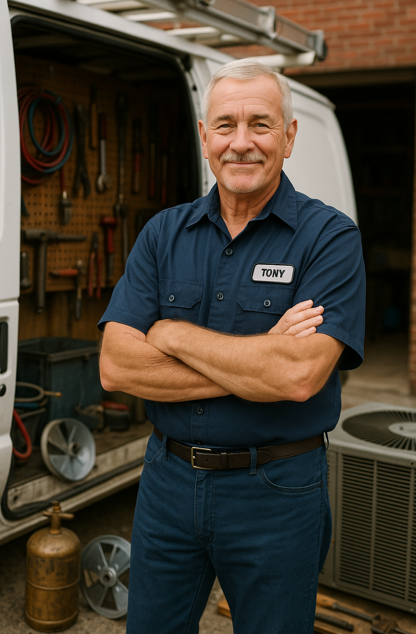Hey folks, Tony Marino here. If you're like most homeowners, you probably don't give much thought to the electrical components that power your air conditioning system. But let me tell you, these parts are the unsung heroes that keep your home cool and comfortable during those scorching summer months. In this blog, we'll take a deep dive into the world of air conditioning electrical systems—what they are, how they work, and why they're crucial for your home's comfort.
What Is Air Conditioning Electrical?
When we talk about "air conditioning electrical," we're referring to the network of electrical components that power and control your air conditioning system. These components include everything from the thermostat that sets your desired temperature to the circuit board that manages the system's operations.
Understanding how these parts work together can help you appreciate the complexity of your air conditioning system and why regular maintenance is essential.
Key Components of an Air Conditioning Electrical System
Let's break down the main electrical components that make your air conditioning system tick:
1. Thermostat
The thermostat is the brain of your air conditioning system. It's the device you interact with to set your desired temperature. When the room temperature rises above the set point, the thermostat sends a signal to the air conditioner to turn on. Conversely, when the room cools down, it signals the system to turn off. Modern thermostats can be programmable or smart, allowing for more precise control and energy savings (nest.com).
2. Control Board
Also known as the circuit board, the control board acts as the central hub of your air conditioning system. It receives signals from the thermostat and other sensors, then directs the operation of various components like the compressor, fan, and condenser. If the control board fails, your entire system can shut down, making it a critical component to monitor.
3. Capacitors
Capacitors store and release electrical energy to help start and run the motors in your air conditioning system. They provide the necessary jolt of electricity to get components like the compressor and fan motor moving. Without functioning capacitors, these components may fail to start, leading to system malfunctions. Check out Carrier’s guide for more information on air conditioning system components.
4. Contactors and Relays
Contactors and relays are switches that control the flow of electricity to major components like the compressor and fan. When the control board sends a signal, these switches close to allow electricity to flow. If a contactor or relay fails, the affected component won't receive power and won't operate.
5. Transformer
The transformer steps down the voltage from your home's electrical supply to the lower voltage needed by the air conditioning system's components. Without a functioning transformer, the system may receive too much or too little voltage, leading to potential damage or failure.
6. Sensors and Switches
Various sensors and switches monitor and protect your air conditioning system. For example, pressure switches monitor refrigerant pressure, and limit switches prevent overheating. If these sensors detect an issue, they can shut down the system to prevent further damage.
How Air Conditioning Electrical Systems Work Together
Now that we've covered the individual components, let's look at how they work together:
-
Setting the Temperature: You set your desired temperature on the thermostat.
-
Signal Transmission: The thermostat sends a signal to the control board.
-
Power Distribution: The control board activates the contactors and relays to supply power to the compressor, fan, and other components.
-
Cooling Process: The compressor circulates refrigerant, the evaporator coil absorbs heat, and the condenser coil releases it outside.
-
System Monitoring: Sensors and switches continuously monitor the system's performance, ensuring everything operates within safe parameters.
-
System Shutdown: Once the desired temperature is reached, the thermostat signals the control board to shut down the system.
This coordinated process ensures efficient and effective cooling of your home.
Importance of Regular Maintenance
Just like any other part of your home, your air conditioning electrical system requires regular maintenance to function optimally. Here are some reasons why:
-
Prevent Breakdowns: Regular inspections can identify potential issues before they lead to system failures. For example, check out the Department of Energy for a list of common AC repair problems.
-
Extend Lifespan: Proper maintenance can prolong the life of your air conditioning system. This can also improve energy efficiency and decrease operational costs. For tips on how to improve HVAC efficiency, visit Carrier.
-
Improve Efficiency: Well-maintained systems operate more efficiently, saving you money on energy bills.
-
Ensure Safety: Regular checks can prevent electrical hazards and ensure the system operates safely.
Common Electrical Issues in Air Conditioning Systems
Being aware of common electrical issues can help you spot problems early:
-
Blown Fuses: Fuses protect your system from power surges. If a fuse blows, it can disrupt the system's operation.
-
Tripped Circuit Breakers: Circuit breakers protect against electrical overloads. If a breaker trips, it can shut down the system.
-
Faulty Capacitors: If capacitors fail, components like the compressor and fan may not start.
-
Worn Contactors: Over time, contactors can wear out, leading to inconsistent power delivery.
If you notice any of these issues, it's essential to consult a professional HVAC technician to address them promptly. For more on the signs of HVAC problems, visit Angi’s expert advice section.
Conclusion
Your air conditioning electrical system is a complex network of components working together to keep your home cool and comfortable. Understanding how these parts function and the importance of regular maintenance can help you ensure your system operates efficiently and lasts longer.
Remember, when it comes to electrical components, always prioritize safety. If you're experiencing issues or need maintenance, don’t hesitate to contact a licensed HVAC professional. And if you're considering purchasing a new system, check out the Goodman 3 Ton 14.5 SEER2 R-32 Bundle.
Stay cool, folks!







